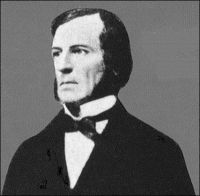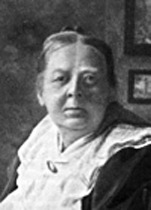 George Boole (2 November 1815 – 8 December 1864) was a British mathematician and philosopher. As the inventor of Boolean algebra, which is the basis of all modern computer arithmetic, Boole is regarded in hindsight as one of the founders of the field of computer science.
George Boole (2 November 1815 – 8 December 1864) was a British mathematician and philosopher. As the inventor of Boolean algebra, which is the basis of all modern computer arithmetic, Boole is regarded in hindsight as one of the founders of the field of computer science.
George Boole was the husband of mathematician and author Mary Elizabeth Everest Boole, the daughter of homeopath Thomas Roupell Everest. George Boole wrote An investigation of the laws of thought dedicated to John Ryall, the uncle of Mary, and who contributed significantly to the work. Mary’s father died in 1855 and George Boole supported her in those difficult moments. That’s when their romantic relationship was consolidated and within a year they were married.
George Boole’s father, John Boole (1779-1848), was a tradesman of limited means, but of “studious character and active mind”. Being especially interested in mathematical science and logic, the father gave his son his first lessons; but the extraordinary mathematical talents of George Boole did not manifest themselves in early life. At first his favourite subject was classics.
It wasn’t until his successful establishment of a school at Lincoln, its removal to Waddington, and later his appointment in 1849 as the first professor of mathematics of then Queen’s College, Cork (now University College Cork, where the library and underground lecture complex are named in his honour) in Ireland that his mathematical skills were fully realized.
In 1855 he married Miss Mary Elizabeth Everest (daughter of Thomas Roupell Everest and niece of George Everest), who later, as Mrs. Boole, wrote several useful educational works on her husband’s principles [and was an important thinker and author in her own right].
To the broader public Boole was known only as the author of numerous abstruse papers on mathematical topics, and of three or four distinct publications which have become standard works.
His earliest published paper was the “Researches in the theory of analytical transformations, with a special application to the reduction of the general equation of the second order.” printed in the Cambridge Mathematical Journal in February 1841, and it led to a friendship between Boole and Duncan Farquharson Gregory, the editor of the journal, which lasted until the premature death of the latter in 1844.
A long list of Boole’s memoirs and detached papers, both on logical and mathematical topics, are found in the Catalogue of Scientific Memoirs published by the Royal Society, and in the supplementary volume on Differential Equations, edited by Isaac Todhunter.
To the Cambridge Mathematical Journal and its successor, the Cambridge and Dublin Mathematical Journal, Boole contributed twenty-two articles in all. In the third and fourth series of the Philosophical Magazine are found sixteen papers.
The Royal Society printed six important memoirs in the Philosophical Transactions, and a few other memoirs are to be found in the Transactions of the Royal Society of Edinburgh and Transactions of the Royal Irish Academy, in the Bulletin de l’Académie de St-Pétersbourg for 1862 (under the name G. Boldt), and in Crelle’s Journal.
Also included is a paper on the mathematical basis of logic, published in the Mechanic’s Magazine in 1848. The works of Boole are thus contained in about fifty scattered articles and a few separate publications.
Only two systematic treatises on mathematical subjects were completed by Boole during his lifetime. The well-known Treatise on Differential Equations appeared in 1859, and was followed, the next year, by a Treatise on the Calculus of Finite Differences, designed to serve as a sequel to the former work.
These treatises are valuable contributions to the important branches of mathematics in question. To a certain extent these works embody the more important discoveries of their author.
In the sixteenth and seventeenth chapters of the Treatise on Differential Equations we find, for instance, an account of the general symbolic method, the bold and skilful employment of which led to Boole’s chief discoveries, and of a general method in analysis, originally described in his famous memoir printed in the Philosophical Transactions for 1844.
Boole was one of the most eminent of those who perceived that the symbols of operation could be separated from those of quantity and treated as distinct objects of calculation. His principal characteristic was perfect confidence in any result obtained by the treatment of symbols in accordance with their primary laws and conditions, and an almost unrivalled skill and power in tracing out these results.
During the last few years of his life Boole was constantly engaged in extending his researches with the object of producing a second edition of his Treatise on Differential Equations much more complete than the first edition, and part of his last vacation was spent in the libraries of the Royal Society and the British Museum; but this new edition was never completed.
Even the manuscripts left at his death were so incomplete that Israel Todhunter, into whose hands they were put, found it impossible to use them in the publication of a second edition of the original treatise, and printed them, in 1865, in a supplementary volume.
With the exception of Augustus de Morgan, Boole was probably the first English mathematician since the time of John Wallis who had also written upon logic. His novel views of logical method were due to the same profound confidence in symbolic reasoning to which he had successfully trusted in mathematical investigation.
Speculations concerning a calculus of reasoning had at different times occupied Boole’s thoughts, but it was not till the spring of 1847 that he put his ideas into the pamphlet called Mathematical Analysis of Logic.
Boole afterwards regarded this as a hasty and imperfect exposition of his logical system, and he desired that his much larger work, An Investigation of the Laws of Thought, on Which are Founded the Mathematical Theories of Logic and Probabilities (1854), should alone be considered as containing a mature statement of his views.
Nevertheless, there is a charm of originality about his earlier logical work which is easy to appreciate.
He did not regard logic as a branch of mathematics, as the title of his earlier pamphlet might be taken to imply, but he pointed out such a deep analogy between the symbols of algebra and those which can be made, in his opinion, to represent logical forms and syllogisms, that we can hardly help saying that (especially his) formal logic is mathematics restricted to the two quantities, 0 and 1.
By unity Boole denoted the universe of thinkable objects; literal symbols, such as x, y, z, v, u, etc., were used with the elective meaning attaching to common adjectives and substantives. Thus, if x=horned and y=sheep, then the successive acts of election represented by x and y, if performed on unity, give the whole of the class horned sheep. Boole showed that elective symbols of this kind obey the same primary laws of combination as algebraic symbols, whence it followed that they could be added, subtracted, multiplied and even divided, almost exactly in the same manner as numbers.
Thus, (1 – x) would represent the operation of selecting all things in the world except horned things, that is, all not horned things, and (1 – x) (1 – y) would give us all things neither horned nor sheep. By the use of such symbols propositions could be reduced to the form of equations, and the syllogistic conclusion from two premises was obtained by eliminating the middle term according to ordinary algebraic rules.
Still more original and remarkable, however, was that part of his system, fully stated in his Laws of Thought, formed a general symbolic method of logical inference. Given any propositions involving any number of terms, Boole showed how, by the purely symbolic treatment of the premises, to draw any conclusion logically contained in those premises.
The second part of the An Investigation of the Laws of Thought, on Which are Founded the Mathematical Theories of Logic and Probabilities contained a corresponding attempt to discover a general method in probabilities, which should enable us from the given probabilities of any system of events to determine the consequent probability of any other event logically connected with the given events.
Though Boole published little except his mathematical and logical works, his acquaintance with general literature was wide and deep. Dante was his favourite poet, and he preferred the Paradiso to the Inferno. The metaphysics of Aristotle, the ethics of Spinoza, the philosophical works of Cicero, and many kindred works, were also frequent subjects of study.
His reflections upon scientific, philosophical and religious questions are contained in four addresses upon The Genius of Sir Isaac Newton, The Right Use of Leisure, The Claims of Science and The Social Aspect of Intellectual Culture, which he delivered and printed at different times.
The personal character of Boole inspired all his friends with the deepest esteem. He was marked by true modesty, and his life was given to the single-minded pursuit of truth. Though he received a medal from the Royal Society for his memoir of 1844, and the honorary degree of LL.D. from the University of Dublin, he neither sought nor received the ordinary rewards to which his discoveries would entitle him. On 8 December 1864, in the full vigour of his intellectual powers, he died of an attack of fever, ending in effusion on the lungs, caused by giving a lecture in wet clothes from the rain.
Of Interest:
 Mary Elizabeth (Everest) Boole, wife of George Boole, was a mathematician and author. She was born in England in 1832, the daughter of homeopathic physician Thomas Roupell Everest and his wife Mary Ryall.
Mary Elizabeth (Everest) Boole, wife of George Boole, was a mathematician and author. She was born in England in 1832, the daughter of homeopathic physician Thomas Roupell Everest and his wife Mary Ryall.
When she was eighteen years old, Mary met George Boole, Professor of Mathematics at Queen’s College, Cork who became her guardian and later her husband.
The Booles had five daughters:
- Mary Ellen (7 June 1856 – 28 May 1908), who married the mathematician and author Charles Howard Hinton (1853 – 1907). They had three children, Howard, William and Joan.
- Margaret (1858 – 16 August 1935), whose son Geoffrey Ingram Taylor became a mathematician and a Fellow of the Royal Society
- Alicia (8 June 1860 – 17 December 1940), also a mathematician, who made important contributions to four-dimensional geometry
- Lucy Everest Boole, a chemist who, in 1888, was only the second woman to pass the London School of Pharmacy‘s major examination, and was the first woman to formally conduct research in pharmaceutical chemistry.
- Ethel Lilian (11 May 1864 – 27 July 1960), who married the Polish scientist and revolutionary Wilfrid Michael Voynich and was the author of the novel The Gadfly.


Leave A Comment